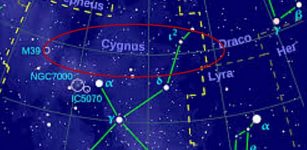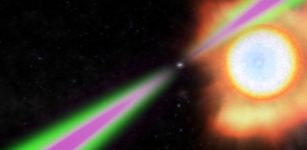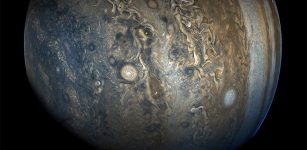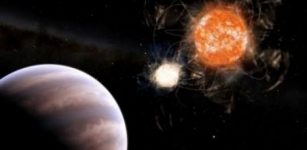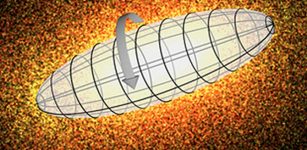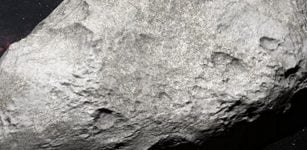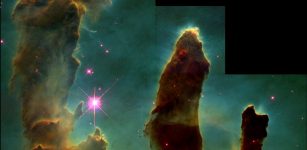Best Evidence For Elusive Mid-Sized Black Hole – Found By Hubble Astronomers
Eddie Gonzales Jr. – MessageToEagle.com – Astronomers have found the best evidence for the perpetrator of a cosmic homicide: a black hole of an elusive class known as “intermediate-mass,” which betrayed its existence by tearing apart a wayward star that passed too close.
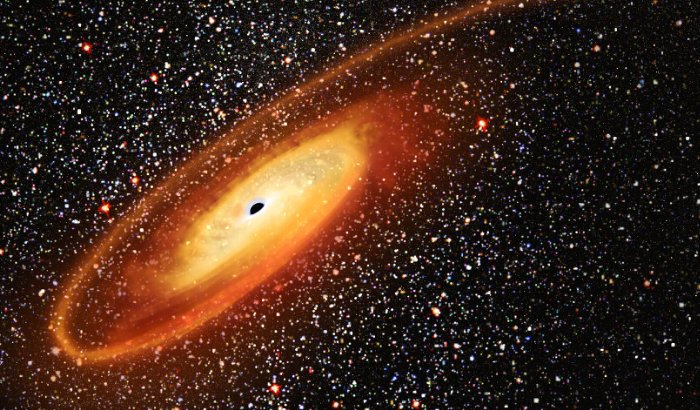 This illustration depicts a cosmic homicide in action. A wayward star is being shredded by the intense gravitational pull of a black hole that contains tens of thousands of solar masses. The stellar remains are forming an accretion disk around the black hole. Flares of X-ray light from the super-heated gas disk alerted astronomers to the black hole’s location; otherwise, it lurked unknown in the dark. The elusive object is classified as an intermediate-mass black hole (IMBH), as it is much less massive than the monster black holes that dwell in the centers of galaxies. Therefore, IMBHs are mostly quiescent because they do not pull in as much material, and are hard to find. Hubble observations provide evidence that the IMBH dwells inside a dense star cluster. The cluster itself may be the stripped-down core of a dwarf galaxy. Credit: NASA, ESA and D. Player (STScI)
This illustration depicts a cosmic homicide in action. A wayward star is being shredded by the intense gravitational pull of a black hole that contains tens of thousands of solar masses. The stellar remains are forming an accretion disk around the black hole. Flares of X-ray light from the super-heated gas disk alerted astronomers to the black hole’s location; otherwise, it lurked unknown in the dark. The elusive object is classified as an intermediate-mass black hole (IMBH), as it is much less massive than the monster black holes that dwell in the centers of galaxies. Therefore, IMBHs are mostly quiescent because they do not pull in as much material, and are hard to find. Hubble observations provide evidence that the IMBH dwells inside a dense star cluster. The cluster itself may be the stripped-down core of a dwarf galaxy. Credit: NASA, ESA and D. Player (STScI)
Weighing in at about 50,000 times the mass of our Sun, the black hole is smaller than the supermassive black holes (at millions or billions of solar masses) that lie at the cores of large galaxies, but larger than stellar-mass black holes formed by the collapse of a massive star.
These so-called intermediate-mass black holes (IMBHs) are a long-sought “missing link” in black hole evolution. Though there have been a few other IMBH candidates, researchers consider these new observations the strongest evidence yet for mid-sized black holes in the universe.
It took the combined power of two X-ray observatories and the keen vision of NASA’s Hubble Space Telescope to nail down the cosmic beast.
“Intermediate-mass black holes are very elusive objects, and so it is critical to carefully consider and rule out alternative explanations for each candidate. That is what Hubble has allowed us to do for our candidate,” Dacheng Lin of the University of New Hampshire, principal investigator of the study, said in a press release.
Lin and his team used Hubble to follow up on leads from NASA’s Chandra X-ray Observatory and ESA’s (the European Space Agency) X-ray Multi-Mirror Mission (XMM-Newton). In 2006 these satellites detected a powerful flare of X-rays, but they could not determine whether it originated from inside or outside of our galaxy.
Researchers attributed it to a star being torn apart after coming too close to a gravitationally powerful compact object, like a black hole.
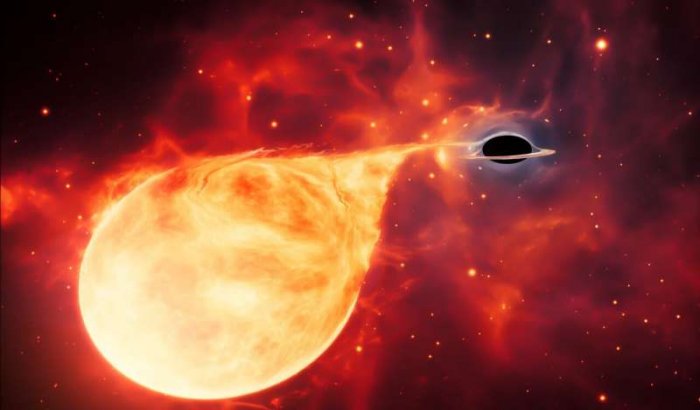 This artist’s impression depicts a star being torn apart by an intermediate-mass black hole (IMBH), surrounded by an accretion disc. This thin, rotating disc of the material consists of the leftovers of a star that was ripped apart by the tidal forces of the black hole. Credit: ESA/Hubble, M. Kornmesser
This artist’s impression depicts a star being torn apart by an intermediate-mass black hole (IMBH), surrounded by an accretion disc. This thin, rotating disc of the material consists of the leftovers of a star that was ripped apart by the tidal forces of the black hole. Credit: ESA/Hubble, M. Kornmesser
Surprisingly, the X-ray source, named 3XMM J215022.4?055108, was not located in a galaxy’s center, where massive black holes normally would reside.
This raised hopes that an IMBH was the culprit, but first another possible source of the X-ray flare had to be ruled out: a neutron star in our own Milky Way galaxy, cooling off after being heated to a very high temperature.
Neutron stars are the crushed remnants of an exploded star.
Hubble was pointed at the X-ray source to resolve its precise location. Deep, high-resolution imaging provides strong evidence that the X-rays emanated not from an isolated source in our galaxy, but instead in a distant, dense star cluster on the outskirts of another galaxy—just the type of place astronomers expected to find an IMBH. Previous Hubble research has shown that the mass of a black hole in the center of a galaxy is proportional to that host galaxy’s central bulge. In other words, the more massive the galaxy, the more massive its black hole.
Therefore, the star cluster that is home to 3XMM J215022.4?055108 may be the stripped-down core of a lower-mass dwarf galaxy that has been gravitationally and tidally disrupted by its close interactions with its current larger galaxy host.
The X-ray glow from the shredded star allowed astronomers to estimate the black hole’s mass of 50,000 solar masses. The mass of the IMBH was estimated based on both X-ray luminosity and spectral shape.
“This is much more reliable than using X-ray luminosity alone as typically done before for previous IMBH candidates,” said Lin. “The reason why we can use the spectral fits to estimate the IMBH mass for our object is that its spectral evolution showed that it has been in the thermal spectral state, a state commonly seen and well understood in accreting stellar-mass black holes.”
“The main difference is that our object is tearing a star apart, providing strong evidence that it is a massive black hole, instead of a stellar-mass black hole as people often worry about for previous candidates including HLX-1,” Lin said.
The results are published in The Astrophysical Journal Letters.
Written by Eddie Gonzales Jr. – MessageToEagle.com Staff

